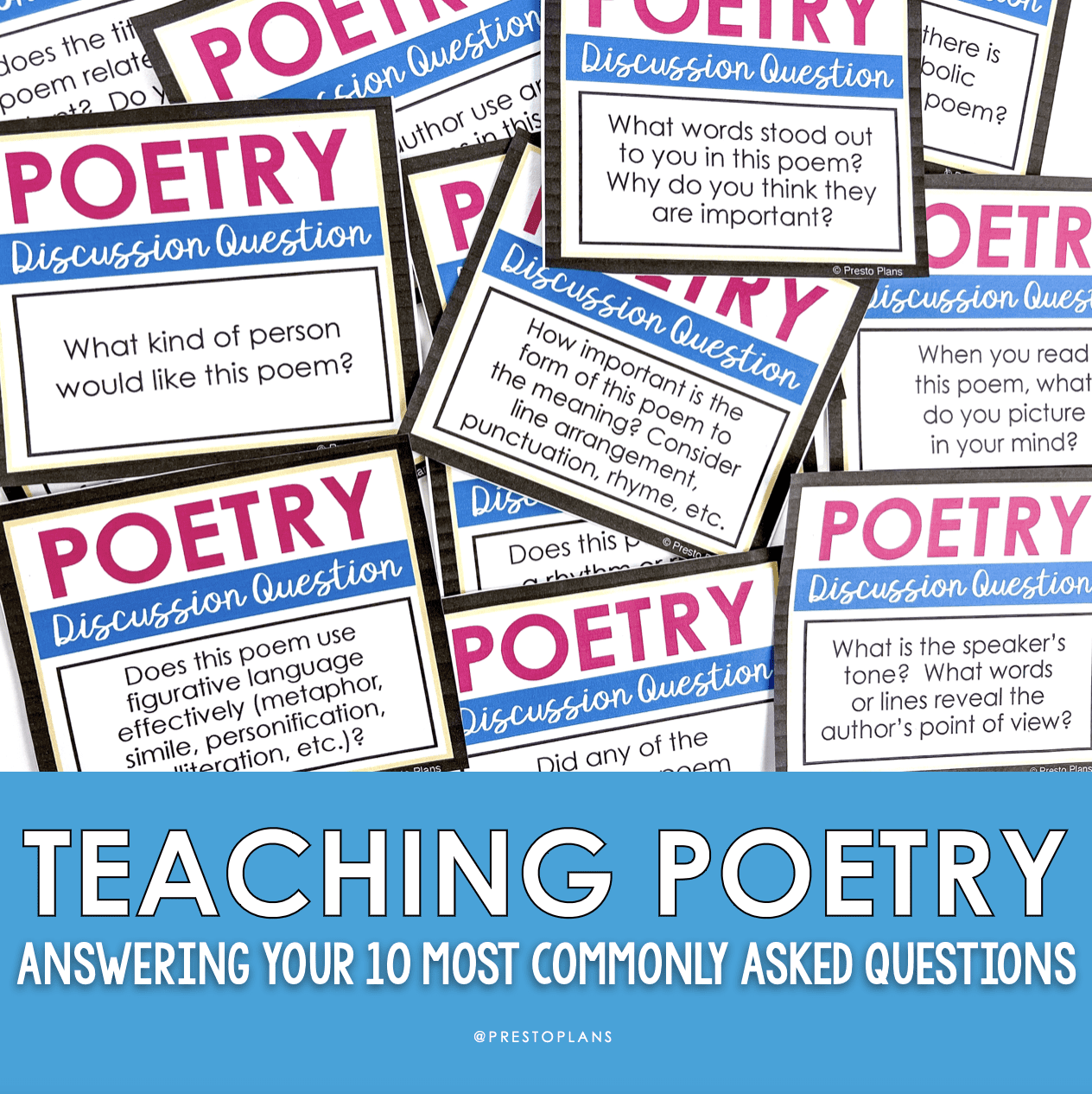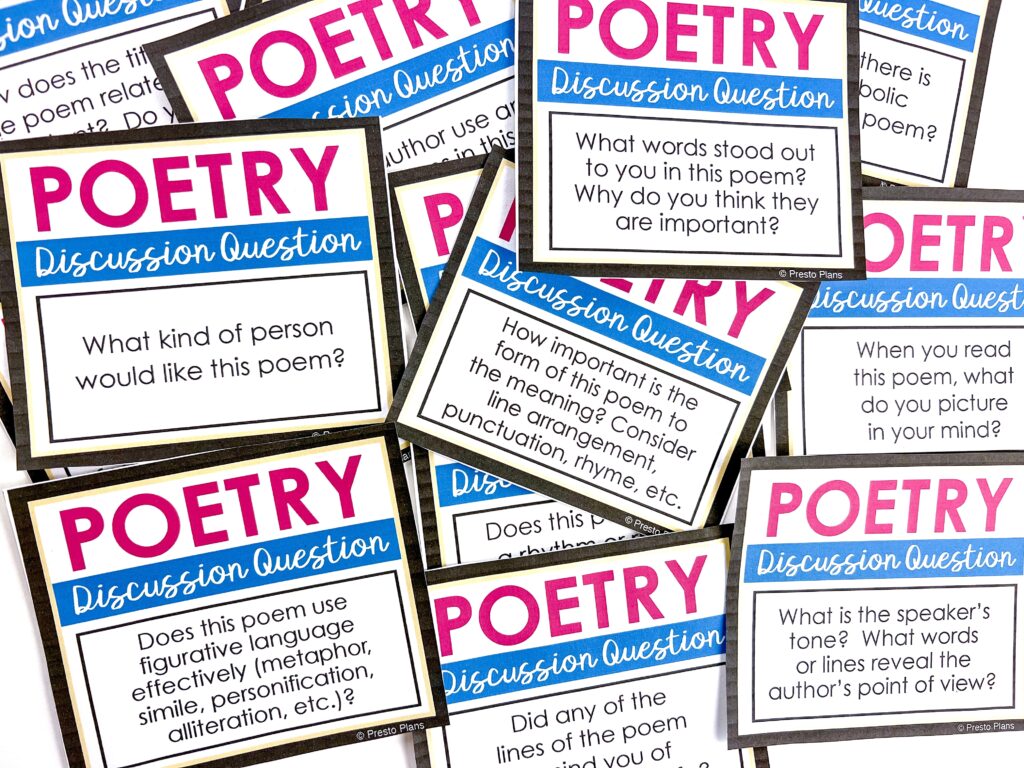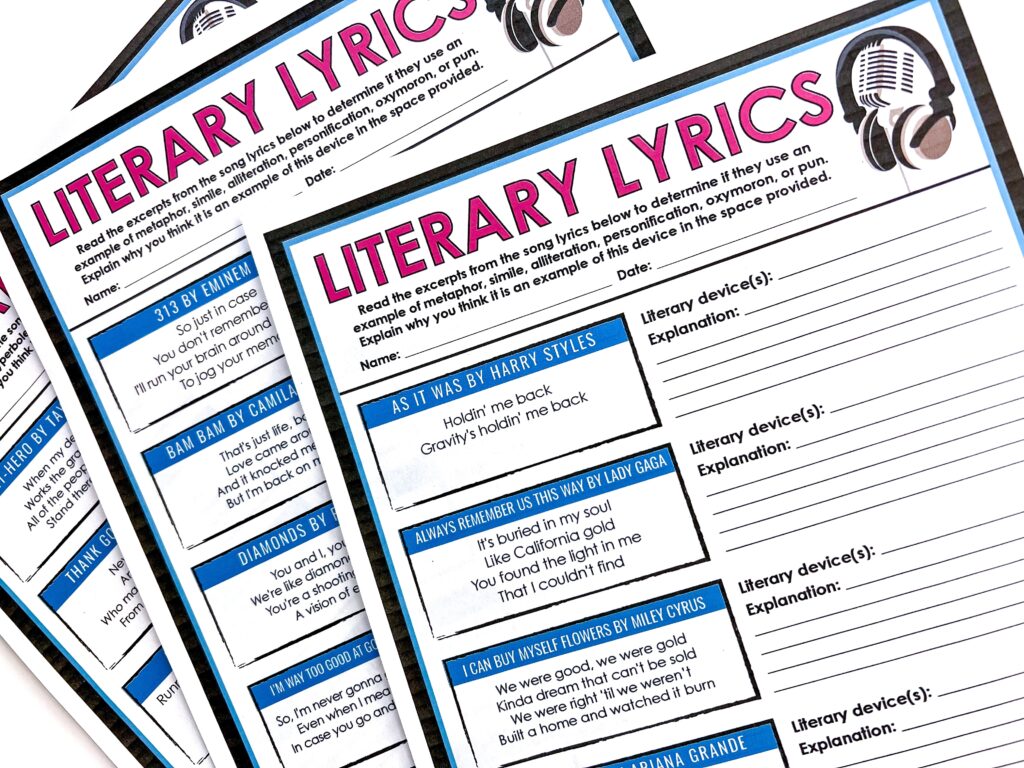PRESTO PLANS
Sent straight to your inbox
CLICK HERE TO ACCESS
Sign up to receive 10 ready-to-use ELA resources your students will love!
10 FREE ELA RESOURCES

Teaching Poetry in Middle School – Answering Your 10 Most-Asked Questions
Do you find teaching poetry in middle school intimidating? I totally get it! I think there’s a real misconception among students that poetry is hard to relate to. For teachers, teaching poetry can sometimes feel like fighting an uphill battle, especially if you don’t identify as a “poetry person” yourself!
I’ve got you covered. Teaching poetry in middle school doesn’t need to feel scary or overwhelming (for you, or for the students!). In fact, there are tons of creative activities and games that help students tap into their background knowledge of music and pop culture, and relate it to the study of poetry!
Here are some of the answers to your most frequently asked questions about teaching poetry in middle school ELA.

1. How should I organize my poetry unit?
When teaching poetry in middle school – especially to a reluctant class – I recommend starting with some low-pressure exposure to this literary form. I like to begin with a station-style activity that allows students to simply read and experience poetry without any extra expectations. For this learning task, I’d recommend selecting a range of poems spanning different genres and types of poetry and representing diverse voices.
Once students have the chance to explore poetry, you can get into the nitty gritty about how poems are different from other forms of writing. Here, you can highlight some of the literary features of poetry, including various types of figurative language. Next, I suggest showing students examples of various types of poetry forms and teaching them to annotate a poem. Finally, help your students get the most out of poetry by supporting them with poetry analysis and interpretation. To extend your study of poetry, you could finish off your unit by challenging students to write their own poems!
TIP: As you work through your poetry unit, try to create opportunities to simply enjoy poems without the pressure to discuss or analyze them! You can also point out how music and popular culture infuse poetry into students’ everyday lives.

2. What are some effective strategies for teaching the different elements of poetry?
I think the most important thing to remember when teaching poetry in middle school is that students enjoy opportunities to engage in collaborative and hands-on learning. This is why I love incorporating reading challenges into a poetry unit! This type of learning activity is perfect for introducing and reinforcing different elements of poetry.
For example, you might want to have students apply their understanding of various poetry forms and literary devices in a poetry reading challenge! Or if you’re teaching figurative language, students can review essential terminology by completing the Figurative Language Escape Room.

Middle schoolers also love opportunities for discussion and collaboration. Consider setting up stations where students can explore and discuss famous quotes that incorporate figurative language! Station activities are especially great for “wiggly” classes, as they naturally incorporate movement and variety!
3. How can I make poetry more accessible?
Some middle school students find poetry intimidating because they find it hard to relate to the language or subject matter. This is why I highly recommend beginning with more modern poetry and poems written with accessible language.
One great way to start is to introduce poetry through the lens of music. Students might be surprised at how much they already know about poetry once they start making connections to their favorite songs! I recommend beginning with poems that contain straightforward examples of figurative language and branching out into more complex texts once students feel more confident.
4. How can I help students analyze poetry to gain a deeper understanding of its meaning and purpose?
I find that taking some time to help students work through the process of analyzing and annotating poetry can really pay off in the long run. In fact, I wrote an entire blog post on teaching students how to annotate poetry!
As much as teachers might like students to read a poem and have a discussion about it, the reality is that middle schoolers often need quite a bit of step-by-step guidance at first. Howecer, if you’re willing to break down these steps, and provide students with plenty of opportunities to apply their learning, the hard work will pay off! This is why I like to cycle back to poetry at various points throughout the year. It helps to keep students’ skills sharp and also allows you to measure their progress and growth over a longer period of time.
5. How can I make poetry more engaging, relevant, and interesting to my students?
Selecting poetry tasks that are based on popular music is a surefire way to hook middle schoolers. Assignments that incorporate song lyrics can be used to support students’ understanding of figurative language, rhyme scheme, or even more complex poetry analysis.
Students may also enjoy exploring more modern expressions of poetry. This might include listening to slam poetry, or learning about the history of rap music! Or, if you have a class that has a special interest in activism or social justice issues, you can tap into their passions with poetry selections that reinforce or challenge their perspectives.

6. How do I choose which poems to study?
I really think this comes down to your own personal preferences, as well as the particular group of students you have. You’ll find plenty of articles online about teaching poetry in middle school. I love this list of 60 Must-Share Poems for Middle and High School from We Are Teachers! However, at the end of the day, you know your students best! For example, if you have a lot of country music fans in your classroom, you might want to begin your poetry unit with an exploration of the figurative language found in popular country songs.
I also recommend selecting poems that appeal to your students’ interests and connect to their personal experiences. You might find that some poems pair well with their learning in other classes (poems written during, or about, particular historical periods, for example). Or you might want to connect poems to seasonal events or activities happening in your school. For example, if you know your students are going on a hike or a field trip to a wetland, consider exploring poems about nature or birds!
7. How do I ease students into writing their own poetry when they feel intimidated?
Trying any new skill can be intimidating, and writing poetry is no exception! I like to create low-pressure, hands-on ways for students to practice writing poetry without worrying about being evaluated. This could look like a structured five-minute free-writing activity at the beginning of ELA class, or students could experiment with a variety of poetry forms before selecting their best work to revise, edit, and hand in.
I’m a big believer in helping students understand the “rules” of poetry before they start to break them. Scaffold poetry instruction by teaching your students the basic structure of simple poems. From here, help them build their skills by incorporating more advanced styles or different types of figurative language.
Lastly, a positive and encouraging attitude goes a long way! If YOU are excited about writing poetry, your students will be too! Try to make your classroom environment a safe space for students to express their ideas without worrying about evaluation or judgment. Check out my ideas for assessing poetry below!

8. What are some creative poetry writing activities that work well in middle and high school ELA?
There are so many ways to make poetry creative, collaborative, and fun! For students who are new to poetry, I recommend creative activities that involve experimentation and wordplay. Refrigerator Poetry is always a favorite in middle school classrooms, and makes a great introductory lesson!
Formula Poetry provides an opportunity for students to familiarize themselves with the rules and structures of various poetry forms, while Blackout Poetry is a way for artistic students to express themselves creatively.

9. How do I assess students during a poetry unit?
Poetry can be tricky to assess! The key is to strike a balance between experimentation (you want to encourage students to be creative and have fun!) and meeting your standards. One approach is to have students build a personal portfolio of poetry over the course of your unit, and then select a few poems for you to assess. This can often create greater buy-in (and higher quality work!), as students have a voice in what is being graded.
I also recommend beginning with a clear idea of what standards you are assessing and making sure you dont let your personal biases or preferences cloud your judgment. You may have a different personal style than your students’ previous ELA teachers, and that’s OK! Try to put this aside, and focus on the specific outcomes in your curriculum.
10. What are some ways to incorporate diverse voices and perspectives in poetry?
I love the analogy of “mirrors” and “windows” when selecting any text for an ELA class. This theory suggests that students need both “mirrors” (texts that reflect who they are and what they already know) and “windows” (texts that offer new perspectives, styles, or ideas) to grow as readers and writers.
Historically, the study of poetry has focused on the Romantic poets of the early 19th century. While there’s certainly nothing wrong with studying European poets from this particular time period, a more modern approach is to include a diverse range of voices that represent more contemporary social issues and ideas. You can also use diverse poetry as a companion to studies of more traditional literature. For example, if you’re teaching a novel set in the early 20th century (like the works of F. Scott Fitzgerald or Ernest Hemingway) consider infusing some poetry from the Harlem Renaissance into your unit.
Another strategy is to select your poems by theme or topic and ensure you include a wide range of voices in the poems you share with your class. For example, you might want to select love poems from various time periods (including lyrics to modern songs). Then, you can have students examine the similarities and differences. Or, if you’re also teaching social studies, you might want to explore how poets have used their words to express perspectives, comment on issues, or highlight injustices and inequalities in different historical periods.
There you go! I hope you feel inspired – not intimidated – to share the joy of poetry with your middle and high school students!
Looking for more creative ideas for teaching poetry in middle school? Check out my post on Outside-The-Box-Poetry Writing Assignments for Middle School ELA!
You can check out the ready-to-use resources for the activities mentioned in this post by clicking the images below!










Search the blog for what you are teaching
GIVEAWAYS
sent straight to your inbox!
share this post